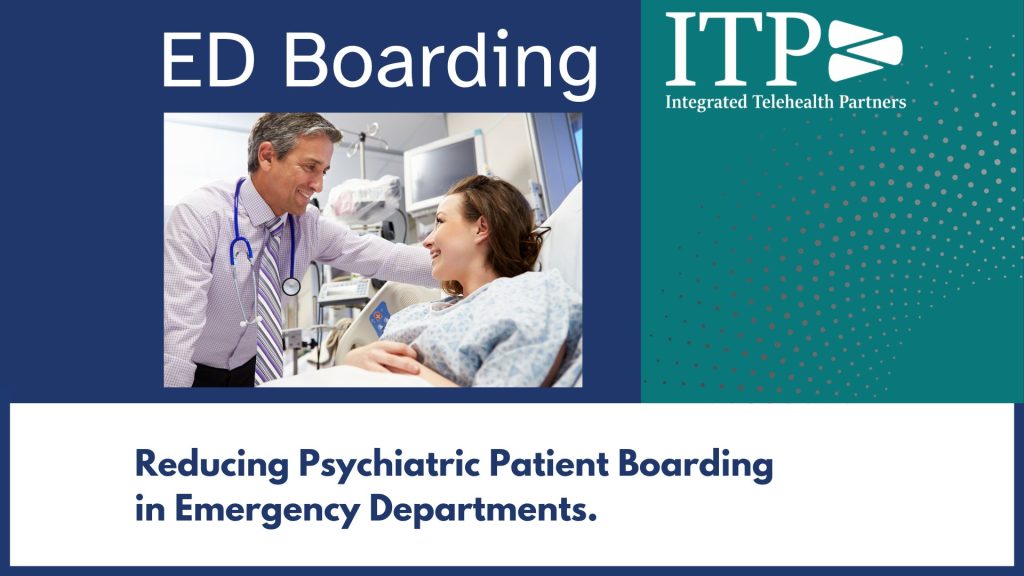How Emergency Departments Can Reduce Psychiatric Patient Boarding
Integrated Telehealth Partners (ITP)

Emergency departments across the country have seen a significant increase in the number of patients coming in with mental health issues over the past 20 years. It’s estimated that 40% of all ED patients experience a mental health problem, according to Access Emergency Medicine. Most acute behavioral problems are assessed and treated in general hospital EDs. These patients often give vague information about their symptoms, making assessment for ED staff difficult and time-consuming.
“EDs are very good at addressing life-threatening emergencies but fall short when treating patients in crisis, and the setting itself may lead to iatrogenic agitation,” Dr. Kimberly Nordstrom wrote in an article published by the Psychiatric Times. Nordstrom, an associate clinical professor at the University of Colorado School of Medicine, is an advocate for changing the way we treat people with mental health issues.
“When the belief is that individuals can only have their needs met in a hospital, the response is to send those patients in crisis to the ED,” She wrote. “Historically, this has been the case. When patients are only given the option of going to an ED, the ED ends up with many individuals who do not require their services.”
According to the American College of Emergency Physicians, the most common psychiatric emergencies in EDs include:
- suicidal and/or homicidal behavior
- psychosis
- agitation
- anxiety
- substance use disorders
- depression
- mania
- delirium
The Problem with Boarding Psychiatric Patients in Emergency Departments
Psychiatric patients seek care in EDs because they often have nowhere else to go. A reduction of psychiatric beds across the nation has led to a backup of patients in emergency departments waiting to be admitted into inpatient treatment. The boarding of psychiatric patients in EDs has disproportionately impacted the most vulnerable populations - children, and adolescents, developmentally disabled veterans, and people living with serious and persistent mental illness.
Psychiatric patients waiting for inpatient placement remain in the ED more than three times longer than non-psychiatric patients. This prevents approximately two bed turnovers, or additional ED patients, decreasing a hospital’s financial revenue, according to a report published in the National Library of Medicine. The average revenue loss is estimated at $2,250 per patient bed.
A report published by The Joint Commission, states that boarding psychiatric patients “is stressful for everyone – patients and staff.” Holding patients in the ED can lead to the following issues:
- increased psychological stress on patients
- delays in treatment that could mitigate the need for an inpatient stay
- increased wait times for all ED patients
- increased pressure on staff
- longer inpatient stays for those admitted
- bigger financial impact on ED reimbursement
Solving the ED Boarding Problem
The Joint Commission recommends hospitals adopt new strategies and actions to provide better care to psychiatric patients. These strategies involve both patient treatment and ED staff support. The American College of Emergency Physicians states that acute psychiatric treatment in the ED should begin rapidly, in coordination with consulting psychiatric clinicians to preserve continuity of care.
One of the easiest strategies to implement is using telepsychiatry to expand access to behavioral health treatment. The Joint Commission report states, “Telepsychiatry is being more widely used in emergency settings, and many contracts allow for 24-hour availability of psychiatrists as consultants to the ED service. Similarly, healthcare integration is being increasingly introduced into the ED setting. Some new models allow for an embedded mental health team including staff psychiatrists to provide consultation either to care teams or directly to patients.”
Hospital EDs that utilize telepsychiatry increase throughput and reduce pressure on staff. Telepsychiatry gives emergency departments the ability to receive on-demand support and resources from behavioral health experts. These telehealth providers can quickly assess a patient’s needs, manage their risk and ensure they receive the proper treatment, leading to faster disposition. Telepsychiatry helps patients by reducing treatment delays and providing access to specialized care.
Other strategies to reduce ED boarding include:
- identifying psychiatric patients as early as possible
- rapid treatment of agitation to calm patients, without sedation
- limited use of restraint and seclusion
- active treatment for substance intoxication or withdrawl
- regular training for ED staff on agitation management
- designated case managers to help with disposition
- designated areas for psychiatric care
How Telepsychiatry Can Help Your ED
Find out how easy it is to integrate telepsychiatry in your ED. Integrated Telehealth Solutions (ITP) provides on-demand ED and crisis support, allowing patients to get the care they need promptly. Virtual care solutions help hospitals meet their financial goals by avoiding ED boarding, allowing more patients to receive treatment. Telepsychiatry also helps alleviate stress on emergency room physicians and nurses by providing them with a behavioral health specialist for patient assessment and medication consultation. ITP also offers placement support to help patients who require inpatient treatment get into a facility sooner.
Contact us today to learn more.
If you or someone you know is experiencing a mental health emergency or crisis, please do not use this website; instead, use these resources to speak with someone now or access local support when necessary.
